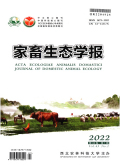家畜生态学报2024,Vol.45Issue(6):20-28,9.DOI:10.3969/j.issn.1673-1182.2024.06.004
太湖鹅消化道及鹅舍环境菌群结构分析
Structure Analysis of Gastrointestinal and Environmental Microbiota in Taihu Goose
摘要
Abstract
To analyze the composition and diversity characteristics of the gut microbiota of healthy geese and the surface environmental microbiota of goose house,this experiment used healthy adult Taihu geese as the research subjects.Gizzard,proventriculus,duodenum,jejunum,ileum,and cecum contents were collected,and feces from geese and environmental samples were aseptically collected.Bacterial ge-nomes were extracted,and high-throughput sequencing was performed using the IonS5TMXL platform to analyze the abundance and structural characteristics of the gut microbiota of geese and the environmental microbiota of goose houses.The results showed that the species richness of the proventriculus content mi-crobiota was relatively high,significantly higher than the microbiota of the jejunum,ileum,and cecum(P<0.05).The cecum microbiota exhibited the highest diversity,with its Shannon value significantly higher than that of the duodenum,jejunum,and ileum(P<0.05),greater than that of the gizzard and proven-triculus microbiota,but the difference was not significant(P>0.05).In terms of α-diversity indicators of the environmental microbiota in goose houses,except for the Simpson value being significantly higher than that of the ileum(P<0.05),the other indicators did not show significant differences compared to the vari-ous segments of the digestive tract(P>0.05).β diversity comparisons revealed that the microbiota struc-tures of the duodenum,jejunum,and ileum contents of geese were relatively similar,while the cecum and fecal microbiota had closer genetic and compositional distances.The microbiota structures of the gizzard,proventriculus,and goose house environment were similar.Different absolute dominant microbial species were found in the contents of various segments of the goose digestive tract,with significant differences in abundance.The absolute dominant phyla(relative abundance greater than 5.00%)in the healthy gizzard,proventriculus,and small intestine segments(duodenum,jejunum,and ileum)contents were Firmicutes,Cyanobacteria,and Proteobacteria,with the duodenum also including Campilobacterota.The absolute dominant phyla in the cecum contents were Firmicutes and Bacteroidetes,while in the goose house envi-ronment,the absolute dominant phyla were Firmicutes and Proteobacteria.Similarly,there were spatial differences in the distribution of dominant genera,with Bacteroides being the absolute dominant genus in the cecum(25.81%).In conclusion,the spatial distribution of the segments of the goose digestive tract significantly influenced the abundance and diversity of the microbiota,while the diversity of the environ-mental microbiota in goose houses was relatively consistent with that of the various segments of the diges-tive tract,with different absolute dominant microbial species colonizing different segments of the digestive tract.关键词
太湖鹅/16S rRNA测序/消化道/鹅舍环境/菌群Key words
Taihu geese/16S rRNA sequencing/gastrointestine/environment of geese house/micro-biota分类
畜牧业引用本文复制引用
朱春红,刘宏祥,陶志云,宋卫涛,章双杰,徐文娟,王志成,李慧芳..太湖鹅消化道及鹅舍环境菌群结构分析[J].家畜生态学报,2024,45(6):20-28,9.基金项目
江苏省种业揭榜挂帅项目(JBGS[2021]111 ()
JBGS[2021]030) ()
江苏现代农业(水禽)产业技术体系(JATS[2022]404) (水禽)

